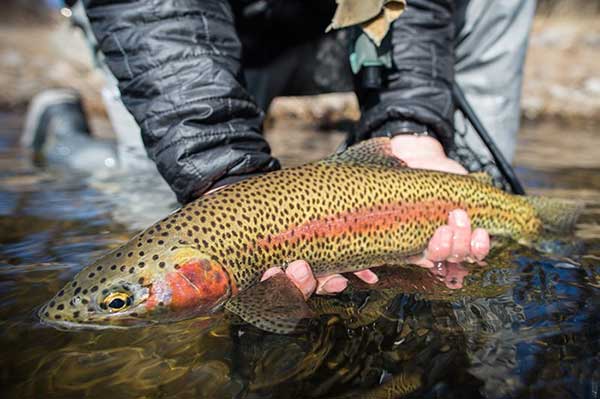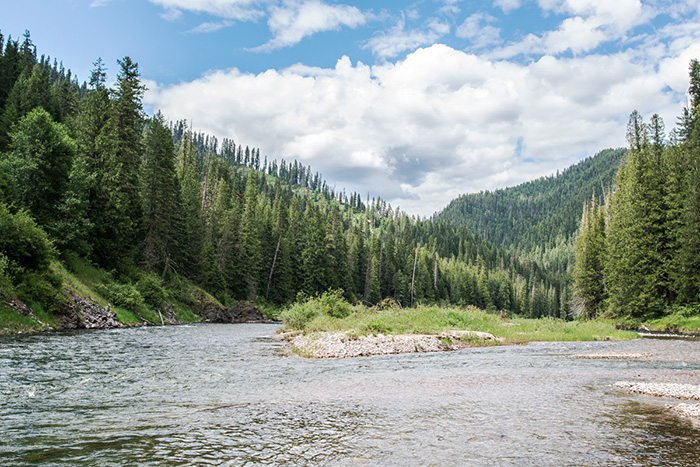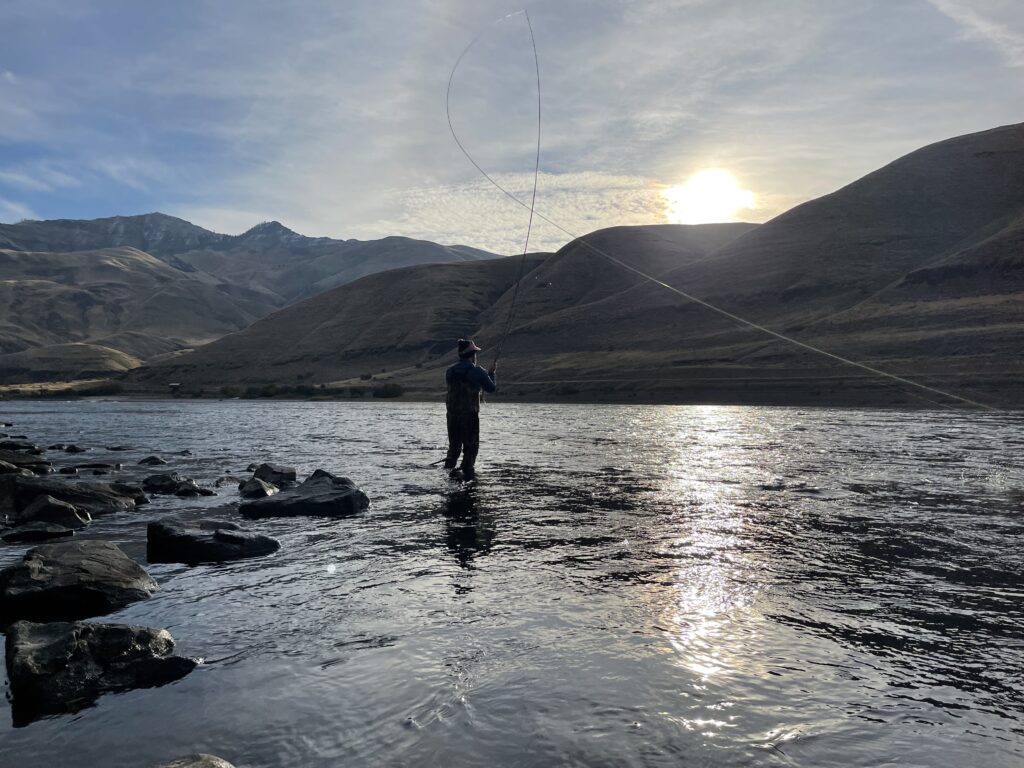CX3 DIY Fishing Guide – Sponsored by onWater

Take all of this information with you using the onWater app. Get detailed maps for on- and off-line exploring. Registered CX-3 participants can get the onWater app FREE for 90 days.
Visit https://onwaterapp.com/subscribe/CX-3 to sign up today and get your FREE 90 days of premium access.
Don’t forget your fishing license!
Spokane River – Trout

River Characteristics and Species
The Spokane River is a tailwater that drains the northern part of Lake Coeur d’Alene in the Idaho panhandle. It travels 111 through Post Falls, Spokane Valley, through downtown Spokane creating the Spokane Falls, and further westward where it joins the Columbia River at Lake Roosevelt. The primary target species for the fly angler is the Redband Trout, a subspecies of Rainbow Trout native to Washington, Idaho, and Montana. The Spokane River requires a Washington fishing license.
Access Points – listed in order from East to West
- Centennial Trail Barker Trailhead – south side of the river, east side of Barker Road
- Sullivan Park – 1901 N Sullivan Rd, Spokane Valley, WA 99216
- Redband Park – 216 N Cedar St, Spokane, WA 99201 access at the boat slide and downstream of the Maple Street Bridge along the residential street
- People’s Park (Sandifur bridge) – parking lot located off of W Clark Ave
- Riverside State Park Bowl and Pitcher Area – 4427 N Aubrey L White Pkwy, Spokane, WA 99205
Equipment
- Typical trout set-up: 4-6wt for anything for nymphs, dries, and small streamers
- Flies – Stoneflies, caddis, stimulators, attractor nymphs, sculpin, sparkle minnows
- Methods – tandem nymph rigs, dry droppers, and swinging or stripping streamers
- BRING A WADING STAFF – the Spokane River is slippery and difficult to wade
Fly Shops
Silver Bow Fly Shop
13210 E Indiana Ave
Spokane Valley, WA 99216
(509) 924-9998
North 40 Outfitters
9646 U.S. Rte 2
Spokane, WA 99224
(509) 418-9460
Swede’s Fly Shop
825 W Garland Ave
Spokane, WA 99205
(509) 323-0500
Guide Services and Fishing Reports
- Silver Bow Fly Shop – (509) 924-9998
- Fly Fish Spokane – (509) 655-0865
Typical Conditions in September
Typically flows are low which will concentrate fish in holding areas that provide adequate oxygen flow and cover – think drop-offs and pocket water.
Take all of this information with you using the onWater app. Get detailed maps for on- and off-line exploring. Registered CX-3 participants can get the onWater app FREE for 90 days.
Visit https://onwaterapp.com/subscribe/CX-3 to sign up today and get your FREE 90 days of premium access.
St. Joe River – Trout

River Characteristics and Species
The St. Joe River is a freestone stream that begins in the Northern Bitterroot Range and travels 140 miles before reaching Coeur d’Alene Lake. “The Joe” is a blue ribbon trout stream with great access to miles of cold, clean, and beautiful habitat full of native Westslope Cutthroat Trout. Well worth the drive from Spokane, the St. Joe is a gem of a western freestone stream. The St. Joe requires an Idaho fishing license.
Access Points
- Avery, ID is a perfect jumping off point and is a 2 ½ hour drive from downtown Spokane
- From the town of Avery to the Spruce Tree Campground there are 39 miles of road in the St. Joe National Forest with pull-offs and campsites
- For the more adventurous there are 26 more miles of river above Spruce Tree Campground accessible on foot
Equipment
- Your favorite rod for throwing big dry flies
- Flies: stimulators, terrestrials, hoppers, small mayfly or midge emergers, keep an eye out for October Caddis!
- Methods: dries, dry dropper, swinging or stripping streamers
Fly Shops
Idaho Fly Fishing Company
46946 St. Joe River Road
Avery, ID 83802
Silver Bow Fly Shop
13210 E Indiana Ave
Spokane Valley, WA 99216
(509) 924-9998
North 40 Outfitters
9646 U.S. Rte 2
Spokane, WA 99224
(509) 418-9460
(208) 245-3626
Typical Conditions in September
- Low and clear water offer opportunities for sight fishing to rising cutthroat in slower water
- FIsh will also hold in boulder gardens, drop-offs, and seams of runs – casting to these areas with an attractor dry and dropper is a great prospecting tactic
Local History
- During the Great Fire of 1910 the US Army’s 25th Infantry Regiment aka the Buffalo Soldiers helped build a backfire that saved the town of Avery
- The St. Joe is the highest navigable river in the contiguous United States
Take all of this information with you using the onWater app. Get detailed maps for on- and off-line exploring. Registered CX-3 participants can get the onWater app FREE for 90 days.
Visit https://onwaterapp.com/subscribe/CX-3 to sign up today and get your FREE 90 days of premium access.
North Fork of the Couer d’Alene River – Trout

River Characteristics and Species
The North Fork of the Coeur d’Alene river is a freestone stream that originates in the Bitterroot Mountains and travels south for 77 miles before joining the South Fork of the Coeur d’Alene in the Silver Valley and eventually emptying into Lake Coeur d’Alene. A classic western freestone stream, the NF CDA provides great opportunities to target native Westslope Cutthroat trout in the beautiful northern Idaho mountains. The North Fork of the Couer d’Alene requires an Idaho fishing license.
Access Points
- The Coeur d’Alene river road is accessed via the Kingston exit off of I-90 and is roughly 1 hour east of downtown Spokane
- Coeur d’Alene River Road mile marker 7 – multiple riffles and runs around the island
- Campgrounds above Prichard – Sissons, Kit Price, Devil’s Elbow
- Extensive state land along Couer d’Alene River Road with multiple pull-outs
Equipment
- 4-6 wt trout set-up for nymphing or dry flies
- Flies – Stoneflies, caddis, stimulators, terrestrials, keep an eye out for October caddis!
- Methods – dries, dry droppers, and swinging or stripping streamers
Fly Shops
Silver Bow Fly Shop
13210 E Indiana Ave
Spokane Valley, WA 99216
(509) 924-9998
North 40 Outfitters
9646 U.S. Rte 2
Spokane, WA 99224
(509) 418-9460
(208) 245-3626
Castaway Fly Shop
1560 Coeur d’Alene River Road
Kingston, ID 83839
(208) 682-2929
Northwest Outfitters
2171 Main St
Coeur d’Alene, ID 83814
(208) 667-2707
Typical Conditions in September
- Typically flows are low which will concentrate fish in holding areas that provide adequate oxygen flow and cover – think drop-offs and pocket water
- Low and clear water offer opportunities for sight fishing to rising cutthroat in slower water
- FIsh will also hold in boulder gardens, drop-offs, and seams of runs – casting to these areas with an attractor dry and dropper is a great prospecting tactic
Take all of this information with you using the onWater app. Get detailed maps for on- and off-line exploring. Registered CX-3 participants can get the onWater app FREE for 90 days.
Visit https://onwaterapp.com/subscribe/CX-3 to sign up today and get your FREE 90 days of premium access.
Snake River – Steelhead

River Characteristics and Species
The Snake River is everything you think of when you envision a high-desert summer steelhead river. Originating in Yellowstone National Park, the Snake flows through Hell’s Canyon – North America’s deepest river gorge – and down through eastern Washington to its confluence with the Columbia. Anglers searching for Steelhead focus on the 23 or so miles of water between Rogersburg and Asotin, WA. “A-run” steelhead are the primary quarry, as the Snake doesn’t have nearly as many of the big “B-run” fish as the Clearwater. That said, a few of those giants are caught every season. The Snake is wild and beautiful country, with plenty of wildlife. Keep your eyes peeled and you might see bighorn sheep on the hillsides above the river. There are also some interesting anthropological sights along the river – check out the petroglyphs at Buffalo Eddy. Fishing for steelhead on the Snake River requires a Washington fishing license and a catch record card. You will also need either a Discover Pass or a Vehicle Access Pass (free with annual license purchase) to access the WDFW-managed lands along the Snake River road.
Access Points
The Snake River Road closely parallels the river from Asotin all the way to Heller Bar, just downstream of the Snake’s confluence with the Grande Ronde. As you drive the road you’ll encounter numerous pull-offs, fishing access sites, and other places to park and access the river. If you’re not going through someone’s yard or encountering ‘posted’ signs, you can almost certainly access the river legally.
The Snake is a very large river and well-suited to jet boats. Boat ramps/Access Sites (in order of North to South):
- Asotin Boat Ramp: Located on Wilson St at the East end of the town of Asotin
- Couse Creek Boat Ramp: located at the intersection of the Snake River Road and the Couse Creek Rd
- Buffalo Eddy Parking & Access Site: located on the Snake River Rd 14.8 miles south of Asotin
- Rendezvous Boat Ramp: located on the Snake River Rd 15.6 miles south of Asotin
- Lyon’s Ferry /Hatchery access: located on the Snake River Rd 17.6 miles south of Asotin
- Heller Bar Boat Ramp: located on the Snake River Rd 22.5 miles south of Asotin
- Rogersburg Access: located at the terminus of the Rogersburg rd. Follow the Snake River rd up the Grande Ronde river until you reach the first bridge. After crosssing the bridge onto the Joseph Creek rd, bear left at the top of the hill and follow the Rogersburg rd all the way to the gate and parking area. From here you can walk down to the river.
Equipment
- Typical Steelhead setup: Spey rods 12’6” and larger (16’ rods are not uncommon), 6-8 wt. Single-handed rods should be 8-wt or larger, a 9’6” or 10’ rod is ideal.
- Shooting Heads: Dry-line fishing is the norm. A Scandi or long-belly spey line is typical, but there’s no reason a Skagit head won’t get your fly to where it needs to be.
- Tips/Leaders: A standard monofilament leader or a floating or slow-sinking polyleader with 12-15 lb tippet. If fishing a Skagit head and a sink-tip, 10’ of T-8 is as heavy as you need.
- Flies – Green Butt Skunks, Undertaker, Freight Train, WHATEVER YOU BELIEVE IN! Orange and red are popular colors.
- Methods – Swing the fly! While the Snake is a very large river, the fish will be close to the banks. Don’t be intimidated by the size of the river.
- BRING A WADING STAFF AND CLEATED BOOTS – the Snake River is slippery and difficult to wade.
Fly Shops
Red Shed Fly Shop
13210 E Indiana Ave
Spokane Valley, WA 99216
(509) 924-9998
Silver Bow Fly Shop
13210 E Indiana Ave
Spokane Valley, WA 99216
(509) 924-9998
North 40 Fly Shop – Lewiston
2981 Thain Grd
Lewiston, ID 83501
(208) 746-1368
Guide Services and Fishing Reports
- Silver Bow Fly Shop – (509) 924-9998
- Tracy Allen – 406-438-1138
- A list of “Guides We Know & Like” from the Red Shed
Typical Conditions in September
Steelhead are usually around and grabby!
Take all of this information with you using the onWater app. Get detailed maps for on- and off-line exploring. Registered CX-3 participants can get the onWater app FREE for 90 days.
Visit https://onwaterapp.com/subscribe/CX-3 to sign up today and get your FREE 90 days of premium access.
Clearwater River – Steelhead

River Characteristics and Species
The Clearwater River is one of the most famous summer steelhead rivers in the United States. While the smaller “A-Run” steelhead are more numerous, this river is particularly renowned for the massive “B-Run” fish that can reach 40” in length and surpass 20 pounds. The Steelhead in the Clearwater are well known to move a great distance to grab the fly, so fishing sink tips is usually not necessary. Dry-line fishing with wet flies is the norm, and many fish are caught every year on skated flies. Fishing for steelhead on the Clearwater requires an Idaho fishing license and salmon/steelhead permit.
Access Points
US Highway 12 closely follows the Clearwater’s entire 75 miles from Lewiston to Kooskia. As you drive the road you’ll encounter numerous pull-offs, fishing access sites, and other places to park and access the river. If you’re not going through someone’s yard or encountering ‘posted’ signs, you can almost certainly access the river legally.
Feel free to read on for some thoughts on how to fish the Clearwater for Steelhead, or click here to read the ‘gospel’ of the Red Shed’s Poppy Cummins. There’s likely no better resource on the topic.
Equipment
- Typical Steelhead setup: Spey rods 12’6” and larger (16’ rods are not uncommon), 7-9-wt. Single-handed rods should be 8-wt or larger, a 9’6” or 10’ rod is ideal.
- Shooting Heads: Dry-line fishing is what the Clearwater is all about! A Scandi or long-belly spey line is typical, but there’s no reason a Skagit head won’t get your fly to where it needs to be.
- Tips/Leaders: A standard monofilament leader or a floating or slow-sinking polyleader with 12-15 lb tippet.
- Flies – Green Butt Skunks, Undertaker, Freight Train, WHATEVER YOU BELIEVE IN!
- Methods – Swing the fly!
- BRING A WADING STAFF AND CLEATED BOOTS – the Clearwater River is slippery and difficult to wade.
Fly Shops
Red Shed Fly Shop
13210 E Indiana Ave
Spokane Valley, WA 99216
(509) 924-9998
Silver Bow Fly Shop
13210 E Indiana Ave
Spokane Valley, WA 99216
(509) 924-9998
Swede’s Fly Shop
825 W Garland Ave
Spokane, WA 99205
(509) 323-0500
Guide Services and Fishing Reports
Typical Conditions in September
Steelhead are usually around and grabby! Be mindful of flows – the Clearwater is a big, cold river. Even when the air is warm, the water will be very cold.
Take all of this information with you using the onWater app. Get detailed maps for on- and off-line exploring. Registered CX-3 participants can get the onWater app FREE for 90 days.
Visit https://onwaterapp.com/subscribe/CX-3 to sign up today and get your FREE 90 days of premium access.
Got more questions? Wanna grab some flies?
Give one of the great local fly shops listed here on this document a shout!
